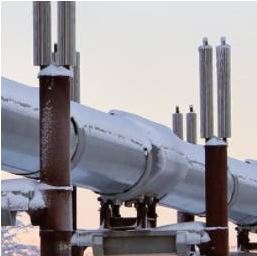 We rely on pipelines every day - they transport crude oil and natural gas from the ground to refineries that transform them into useful products. Pipe line pigs work much like squeegees, but instead of being forced through pipes on wires, they use air, nitrogen, or water to push the projectile and product through. Depending on the situation, the product can either be released at the end of the line or returned to the product holding tank.
We rely on pipelines every day - they transport crude oil and natural gas from the ground to refineries that transform them into useful products. Pipe line pigs work much like squeegees, but instead of being forced through pipes on wires, they use air, nitrogen, or water to push the projectile and product through. Depending on the situation, the product can either be released at the end of the line or returned to the product holding tank.
The processing engineers specify projectile design according to:
- Viscosity of the product
- The size of the system line
What is the purpose of pipe line pigs?
Pipeline pigs play an important role in pipeline maintenance to ensure prime production from source wells. Using pipeline pigs can save a company a great deal of time and money, from keeping pipes clean and flowing steadily to identifying potential problems early on.
When pipes become damaged, clogged or cross-contaminated, companies can lose large amounts of money. In turn, this can lower the price of the products in which these materials are used, such as gasoline for our cars or plastic for so many common items. Pipeline pigs are thus used to make sure the pipelines are fit to transport these liquids.
What are pipeline pigs?
During pipeline pigging, devices called "pigs" perform maintenance operations on pipelines without disrupting the flow of product. They are typically bullet-shaped instruments made of foam, but they can be made of various materials and sizes.
The first pigs were made from straw, barbed wire, leather, and made a squealing sound while traveling through the pipes, giving them their name. Eventually, the name was abbreviated to "Pipeline Inspection Gauge" or "Pipeline Intervention Gauge".
How do pipeline pigs work?
Pigs can be placed and removed from pipelines with launching and receiving stations specially designed for this purpose. By applying pressure to the well, the pig is pushed through the pipe of the launching station, also known as the pig launcher or the "pig trap".
The pigs travel through the pipeline until they reach a receiving station, called the "pig catcher," where they are removed along with any waste.
Cleaning & Maintenance
Upon entering a pipeline, a pig scrapes away buildup and debris. These actions improve flow efficiency and prevent pipeline damage.
Pigs that recover product from pipes or tubes after production cycles are called product recovery pigs (pipeline cleaning pigs). Due to their good mechanical properties, silicone pigs are ideal for recovering products and cleaning pipelines in the food, dairy, beverage, chemical, and personal care industries. Silicone is also chemically compatible with the majority of products.
By recovering the residual product left over after cycles in processing lines, pipeline pigging systems increase productivity and reduce Clean-in-place (CIP) costs. It also reduces the time and effort required to clean lines by removing left-over product. Savings in time, water, and chemicals help offset investment costs.
Separation
Transporting different types of products through the same pipe can lead to cross-contamination. Using pigs to clean pipes effectively reduces the risk of cross-contamination (and spoiled product).
Movement of the product
Moreover, pipeline pigs are also useful for emptying liquids into tanks or returning liquids to their original containers.
Checking, positioning, and monitoring
A "Smart Pig" measures restriction, deformation, metal loss, and other aspects of the pipe's internal condition. Such information is essential in preventing leaks and preventing environmental damage and explosions.
Pigs can locate defects and monitor their progress over time. Using this information, one can locate a defect before digging it up. The pig can also be used to monitor the condition if the damage doesn't need immediate repair.
Types of Pipe Line Pig
Without maintenance, your pipeline will not perform at its optimum efficiency and eventually deteriorate due to corrosion. Pipelines can become unstable as a result of corrosion. Maintaining a pipeline properly costs far more than the risk of pipeline failure. Proper pipeline maintenance saves money and protects the public and the environment.
You can choose from a wide selection of pipe line pigs to suit your needs.
- Mandrel: Steel Mandrel pigs are used for cleaning, batching, displacement, and bidirectional applications.
- Urethane Casting Pigs: These pigs are lightweight and have a nice bend radius, making them ideal for tight bends
- Foam: A foam pig is used for scraping, cleaning, and drying.
- A specialty pig is used for cleaning and corrosion jobs that require more intense cleaning.
Looking for more information about pipe line pigs? Get in touch with our experts today!
